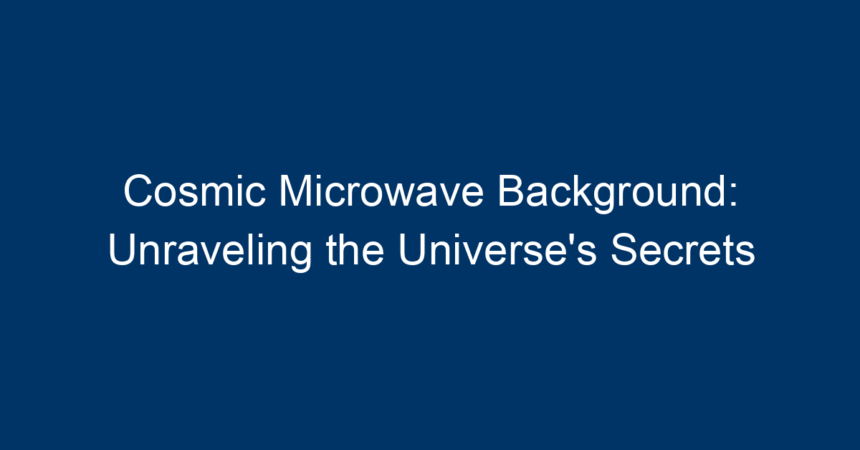The cosmos is a boundless expanse of mysteries, and at the forefront of our quest to understand the universe is the cosmic microwave background (CMB). This faint radiation, discovered in 1965, serves as a relic from the early universe, providing insights into its formation and evolution. In this article, we will explore the CMB’s significance, its properties, how it was discovered, and what it reveals about our universe’s past, present, and future.
What is the Cosmic Microwave Background?
The cosmic microwave background is a form of electromagnetic radiation filling the universe. It is believed to be the afterglow of the Big Bang, the event that marked the beginning of the universe approximately 13.8 billion years ago. Comprising micro-sized wavelengths, the CMB represents the universe when it had cooled enough for protons and electrons to combine into hydrogen atoms, allowing photons to stream freely through space.
The Spectrum of the CMB
The CMB is characterized by its nearly uniform distribution of temperature across the sky, revealing minute fluctuations known as anisotropies. These tiny variances provide essential insights into the universe’s structure and formation. The temperature of the CMB is approximately 2.7 Kelvin, just above absolute zero, which demonstrates the universe’s cooling over billions of years.
Historical Context: The Discovery of the CMB
In the early 20th century, scientists grappled with the concept of the Big Bang theory. However, it wasn’t until 1965 that Arno Penzias and Robert Wilson accidentally stumbled upon the cosmic microwave background radiation while working on a radio transmitter. Initially regarded with skepticism, their discovery earned them the Nobel Prize in Physics in 1978, revolutionizing our understanding of the universe.
How the CMB Was Measured
Advancements in technology have allowed scientists to study the CMB in greater detail. The COBE (Cosmic Background Explorer) satellite, launched in 1989, was the first to map the CMB’s detailed structure, validating many predictions of the Big Bang theory. This was followed by the WMAP (Wilkinson Microwave Anisotropy Probe) in 2001, which provided even more precise measurements and insights into the universe’s age, composition, and expansion rate.
The most recent probe, the Planck satellite, launched in 2009, has offered unparalleled precision in measuring the CMB. Its data has solidified our understanding of the universe’s fundamental parameters and has provided important clues about dark energy and dark matter.
The Significance of the CMB in Cosmology
Understanding the CMB has profound implications for cosmology, the study of the universe’s origin and evolution. Here are some key aspects of its significance:
A Snapshot of the Early Universe
The CMB acts as a snapshot of the universe approximately 380,000 years after the Big Bang. By analyzing its temperature fluctuations, scientists can trace the seeds of cosmic structure, such as galaxies and clusters, to their origins. These fluctuations can be linked to the density variations that led to the large-scale structure we observe today.
Insights into Dark Matter and Dark Energy
Dark matter and dark energy are two of the most significant yet elusive components of our universe. The CMB helps in mapping the distribution of dark matter through its gravitational effects on the photons traveling through space. Moreover, its study contributes to our understanding of dark energy, the force driving the universe’s accelerated expansion.
Testing Cosmological Models
The cosmic microwave background also serves as a critical testing ground for cosmological models. Predictions made by various theories can be compared against data gathered from the CMB. Deviations from expected results could prompt new theories, advancing our knowledge of fundamental physics.
The Anisotropies of the CMB
The minute fluctuations in the CMB, known as anisotropies, hold crucial information about the universe’s evolution. These temperature variations are extremely small, measuring about one part in 100,000. However, they are key to answering vital questions in cosmology:
The Scale of Structure Formation
By examining the scale and distribution of anisotropies, scientists can infer how structures like galaxies formed over cosmic time. Larger anisotropies suggest the presence of denser regions that are likely to evolve into galaxies.
Polarization Patterns
In addition to temperature variations, the CMB displays polarization patterns. These patterns provide insights into the interactions of photons with electrons during the reionization period of the universe, roughly 380,000 years after the Big Bang.
Future Research and Ongoing Missions
The exploration of the cosmic microwave background is far from over. Numerous ongoing and future missions aim to unravel more secrets of the CMB:
Upcoming Satellites and Observatories
Projects like the Simons Observatory and the CMB-S4 mission are set to investigate the CMB’s polarization in unprecedented detail, offering insights into the universe’s earliest moments and the nature of inflation, a rapid expansion phase after the Big Bang.
Ground-Based Observatories
Ground-based observatories such as the Atacama Cosmology Telescope (ACT) continue to improve measurements of the CMB. These observatories aim to refine our knowledge of the CMB’s anisotropies and constrain models of dark energy and dark matter.
Conclusion: The Cosmic Microwave Background and Our Place in the Universe
The cosmic microwave background is not just a remnant of the distant past; it is a critical tool that has revolutionized our understanding of the universe. It has opened pathways to explore fundamental questions about our origin, the fabric of space-time, and the fate of the cosmos. As technology advances and new observational missions are launched, the secrets hidden within the CMB will likely continue to astound and enlighten us.
Actionable Insights
-
Stay Informed: Keep an eye on the latest research from physics journals and institutions, as discoveries related to the cosmic microwave background are continually evolving.
-
Engage with Educational Content: Numerous documentaries and articles explain the CMB in accessible ways. Platforms like YouTube and educational websites can be great resources.
- Observe the Night Sky: While the CMB is not visible to the naked eye, understanding the structures we observe today can deepen your appreciation for the universe’s history and complexity.
The cosmic microwave background serves as a bridge to our universe’s beginnings, revealing the interconnectedness of all things and inviting us to ponder our place in the cosmos.




